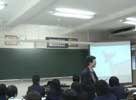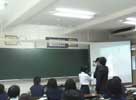| (1) |
The teacher
shall show pictures of deer or cats to refresh the students' memory of
the material covered in junior high school regarding the position of the
eyes. |
|
|
| (2) |
Discuss why the field of vision
of carnivorous animals overlaps. |
| (3) |
The teacher shall refresh the
students' memory of what they learned about stereoscopic vision. |
| (4) |
The students shall conduct an
experiment to prove that you lose the sense of distance with just one
eye |
|
| a. |
Pick two students to come
forward. |
| b. |
The students shall stand
facing each other while holding a pencil in front of their chests with
their right hand in such a way that the pencil is parallel to the floor
and the pencil point is facing his/her partner. One student will hold
the pencil still, while the other will move the tip of the pencil in
a lateral motion so that it touches the tip of his/her partner’s pencil. |
| c. |
Do the same experiment with
one eye closed. |
| d. |
The teacher shall project
the on-going experiment onto the screen by using a video camera set
above the pencils. |
|
|
|
| (5) |
The students shall close each
eye alternately to see how the pencil is perceived, when it is nearer
and when it is farther away. |
| (6) |
Discuss at what point the eye
perceives the sense of distance. |
| (7) |
The teacher shall pair the students
to conduct the same experiment. |
| (8) |
The teacher shall confirm the
lesson about receptor organs, sensory nerves, central nerve system, motor
coordination, and the mechanisms involved. |


